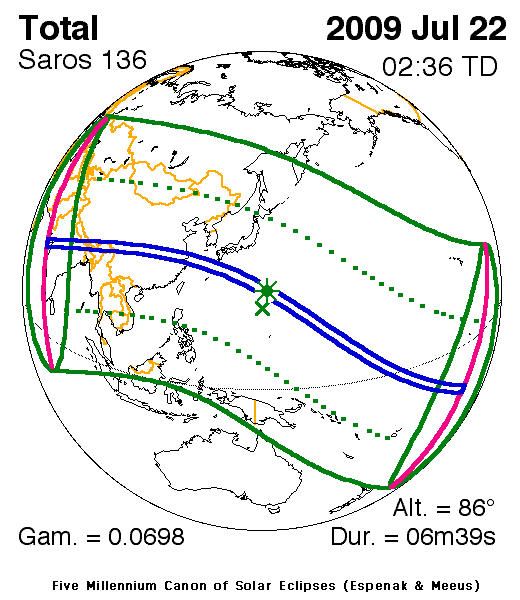1) Estimate the approximate speed of the cruise ship in knots.http://apod.nasa.gov/apod/ap090730.html wrote:
Explanation: The July 22nd total solar eclipse was the longest of the 21st century. From the point of maximum eclipse along the Moon's shadow track across the Pacific Ocean, the Moon completely blocked the Sun for a total of 6 minutes and 39 seconds. But from the deck of this cruise ship the duration of the total eclipse phase was extended to a whopping 6 minutes and 42 seconds by the ship's motion along the shadow track.
- (Try to do it in your head if you can).
-------------------------------------------------------------------
- _The Pied Piper Of Hamelin_ Epilogue by Robert Browning
Alas, alas for Hamelin!
There came into many a burgher's pate
A text which says, that Heaven's Gate
Opes to the Rich at as easy rate
As the needle's eye takes a camel in!
The Mayor sent East, West, North, and South,
To offer the Piper, by word of mouth,
Wherever it was men's lot to find him,
Silver and gold to his heart's content,
If he'd only return the way he went,
And bring the children behind him.
But when they saw 'twas a lost ENDEAVOUR,
And Piper and dancers were gone for ever,
They made a decree that lawyers never
Should think their records dated duly
If, after the day of the month and year,
These words did not as well appear,
"And so long after what happened here
On the Twenty-second of July,
Thirteen hundred and seventy-six":
And the better in memory to fix
The place of the children's last retreat,
They called it, the Pied Piper's Street—
Where any one playing on pipe or tabor
Was sure for the future to lose his labour.
Nor suffered they hostelry or tavern
To shock with mirth a street so solemn;
But opposite the place of the cavern
They wrote the story on a column,
And on the great Church-Window painted
The same, to make the world acquainted
How their children were stolen away;
And there it stands to this very day.
And I must not omit to say
That in Transylvania there's a tribe
Of alien people that ascribe
The outlandish ways and dress
On which their neighbours lay such stress,
To their fathers and mothers having risen
Out of some subterraneous prison
Into which they were trepanned
Long time ago in a mighty band
Out of Hamelin town in Brunswick land,
But how or why, they don't understand.
